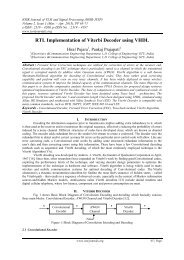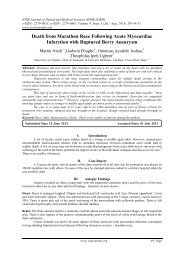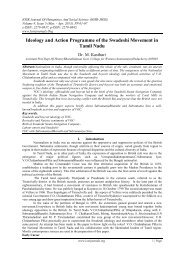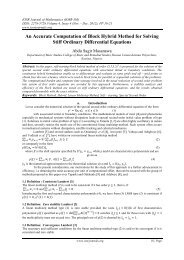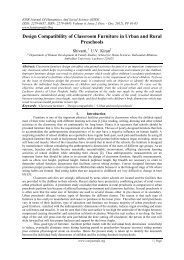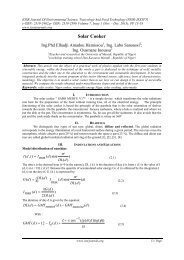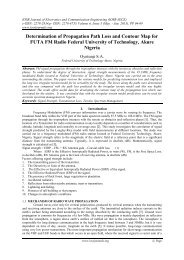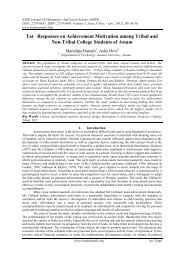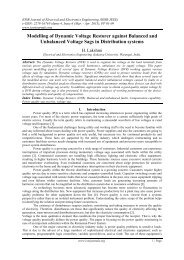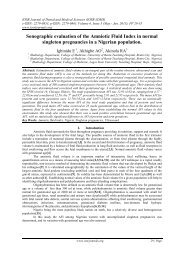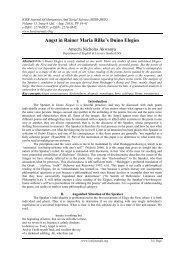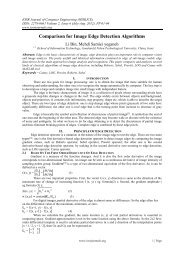Initial Conquest of India by Turks and Their Slaves - IOSR
Initial Conquest of India by Turks and Their Slaves - IOSR
Initial Conquest of India by Turks and Their Slaves - IOSR
You also want an ePaper? Increase the reach of your titles
YUMPU automatically turns print PDFs into web optimized ePapers that Google loves.
<strong>Initial</strong> <strong>Conquest</strong> Of <strong>India</strong> By <strong>Turks</strong> And <strong>Their</strong> <strong>Slaves</strong><br />
Magadha <strong>and</strong> massacred many ordained monks in Udd<strong>and</strong>apura. In the account <strong>of</strong> the Tibetan pilgrim<br />
Dharmasvamin, who visited eastern <strong>India</strong> in the years 1234-36, the vihara <strong>of</strong> Udd<strong>and</strong>apura is mentioned twice<br />
as the residence <strong>of</strong> a Turushka military comm<strong>and</strong>er.hammad bin Bakhtiyar, having received a robe <strong>of</strong> honour for<br />
his earlier victory from Aibak, again set out for Bihar <strong>and</strong> then to Nadiya or as Minjah calls it „Nodia‟, a Sena<br />
capital, which he took possession <strong>of</strong> in May 1204, finally driving Lakhsmana Sena to Sankanat (what Juzjani<br />
refers to as Sankakot not far from Vikramapura, where Lakshmana Sena‟s descendants are archeologically<br />
recorded to have ruled for the next three generations) <strong>and</strong> Bang, where the latters reign soon came to an<br />
end.Muhammad bin Bakhtiyar left Nadiya in desolution, despatching a large part <strong>of</strong> its accumulated treasure to<br />
Aibak, <strong>and</strong> transferring the seat <strong>of</strong> Muslim government to Lakhnauti, a northern Sena capital on the Ganges near<br />
Gaur in Maldah district. Within two years from the raid on Nadia he began making preparations for a third<br />
adventure, an expedition to the northeast, to conquer “Tibet <strong>and</strong> China.”Minhaj possibly hints at the real purpose<br />
<strong>of</strong> the expedition when he speaks <strong>of</strong> the trading routes, numbering about 35, that carried a brisk trade in Tangan<br />
horses from “Karambattan” (possibly Kumrikotah in Bhutan) <strong>and</strong> “Tibet” to Kamrup <strong>and</strong> thence to the districts<br />
<strong>of</strong> North Bengal. Bakhtiyar wanted to have monopoly <strong>of</strong> this important breed. From Lakhnauti he arrived,<br />
according to Minhaj, at „Bardhankuti‟ whence for ten days he marched northwards along the river named<br />
Bangmati, “Three times as broad as the Ganges.” He was badly crushed their <strong>and</strong> on the retreat at Devkot he<br />
was assassinated <strong>by</strong> one <strong>of</strong> his own lieutenants, named Ali Mardan.<br />
At the same time the Muizz-ud-din was defeated at Andkhud in 601/1204 which provoked rebellions in<br />
various parts <strong>of</strong> the empire, <strong>and</strong> his last years were taken up with their suppression. On settling the affairs at<br />
Lahore, Muizz-ud-din left for Ghazni <strong>and</strong> on the way at Damyak while engaged in evening prayers, he met his<br />
death at the h<strong>and</strong>s <strong>of</strong> an assassin, on 3rd Shaban, 602/march 15th, 1206. The murder was ascribed to Mulahida,<br />
a term applied for, Qaramitah <strong>and</strong> Ismaili Shaias <strong>and</strong> also to non-Muslims. The <strong>Turks</strong> had overrun the whole <strong>of</strong><br />
north <strong>India</strong>, but on Muizz-ud-din‟s death found themselves in effective possession only <strong>of</strong> Sind <strong>and</strong> parts <strong>of</strong> the<br />
Punjab <strong>and</strong> the Gangetic valley with Rajput resistance increasing in extent. Muizz-ud-din left no son; his<br />
nephew Ghiuasuddin Mahmud showed no promise <strong>of</strong> leadership. Three among Muizz-ud-dins <strong>of</strong>ficers held<br />
important comm<strong>and</strong>s <strong>and</strong> nourished ambitions <strong>of</strong> sovereignty – Tajuddin Yalduz held Karman <strong>and</strong> Sankuran,<br />
Nasiruddin Qubachah a son-in-law <strong>of</strong> Yalduz <strong>and</strong> incharge <strong>of</strong> Uch. And most capable among them was<br />
Qutbuddin Aibak. After 2nd battle <strong>of</strong> Tarain, he was left incharge <strong>of</strong> <strong>India</strong>n conquests Aibak in 1206, 24<br />
June/17th Zilqad, 602 proceeded from Delhi to Punjab <strong>and</strong> ascended „the Throne <strong>of</strong> the Sultanate <strong>of</strong> Lahore‟<br />
(takht-i-saltanat-i-lohor). Ibn Battuta, exclude Qutubuddin Aibak, from the list <strong>of</strong> Muslim Kings <strong>of</strong> Delhi<br />
because the latter ascended the throne in Lahore <strong>and</strong> not in Delhi Aibak was given the title <strong>of</strong> Sultan‟ (laqab-i-<br />
Saltani, Khitab-i-Saltāni) as well as the title <strong>of</strong> Bādshāh‟ (Khitāab-i-bādshāhi) <strong>and</strong> a canopy <strong>of</strong> state (chatr) <strong>and</strong><br />
„Staff‟ (dūrbash) in 1205 <strong>by</strong> Ghiyasuddin Mahmud when he became the Ghurid suzerain at Firūzkūh. Aibak did<br />
not issue any coinage in his name, but restricted himself in circulating coins as a local governor in the name <strong>of</strong><br />
his suzerain. Aibak captured Ghazna <strong>and</strong> in the capital set on the imperial throne ( dār al-mulk-i-ghaznin bar<br />
takti-i-bādshāhi) for forty days in the year 1208 A.D. The oldest Muslim inscription in Palwal, <strong>of</strong> that year,<br />
refers to Aibak as „riqāb al-Imām Saiyid at-turk wa-l-„ajam‟, The master <strong>of</strong> the rulers <strong>of</strong> the <strong>Turks</strong> <strong>and</strong> the<br />
Persians‟. Died in 607-1210 <strong>of</strong> injuries received in a fall from his horse while playing chaugan, Aibak contested<br />
many battles in Hindustan but as a Sipāhsālār or „Chief Comm<strong>and</strong>er‟ <strong>of</strong> the army in Hind, <strong>and</strong> none is recorded<br />
in the four years between 1206 <strong>and</strong> his death in Lahore in 1210-11.<br />
After Aibak, his adopted son, Arām Shāh ruled for less than a year in 1210-11. He also did not issue<br />
any coinage <strong>and</strong> is not mentioned <strong>by</strong> Ibn Batuta in his list <strong>of</strong> Delhi Sultans. He was defeated <strong>by</strong> Iltutmish<br />
Governor <strong>of</strong> Badaun (Slave <strong>of</strong> Aibak, <strong>and</strong> hence the slave <strong>of</strong> a slave) who was invited <strong>by</strong> the citizens <strong>of</strong> Delhi<br />
on the death <strong>of</strong> Aibak. At this time as Juzjani writes, the dominions <strong>of</strong> Hindustan (mamālik-i-hindustān) became<br />
divided in four parts: the „mamlakat-i-dihli‟ which went to Iltutmish, the „mamlakat-i-lakhnauti‟ which was<br />
brought under subjection <strong>by</strong> the Khalaj Chiefs, the mamlakat-i-sind which was taken <strong>by</strong> Qabacha, <strong>and</strong> the<br />
„mamlakat-i-lohor‟ which was seized „sometimes <strong>by</strong> Qabacha <strong>and</strong> sometimes <strong>by</strong> Iltutmish‟. All the three<br />
sovereigns were engaged in a contest for primacy which was ultimately won <strong>by</strong> the Delhi ruler- Iltutmish.<br />
In the words <strong>of</strong> Ibn Batutah, Sultan Shamsad-Din Iltutmish who became „the first who ruled in the city<br />
<strong>of</strong> Delhi with independent power. Iltutmish conquered many territories <strong>and</strong> exp<strong>and</strong>ed the Delhi Sultanate. He<br />
conquered the territories in the Chinab <strong>and</strong> Jehlum valleys. Uch, Bhakar, Lahore, Twelve celebrated fortresses<br />
in Debal (Hassan Nizami), Siwistan (Sehwan) lak (Lakki Pass,) N<strong>and</strong>anah in Salt Range (recorded <strong>by</strong> Minhaj),<br />
Bihar, Lakhanauti, First in 624/1226-7 (<strong>by</strong> iltutmish‟s son <strong>and</strong> then in Nov. 8. 1230.) Ranthambhor, M<strong>and</strong>or,<br />
Bayana, Thangir, Lawah, Kasili,Sambhar, Malwah, Bhilsa, Ujjain-in 632/1234-5. Gwalior in 629/1231.<br />
Iltutmish, like the later Delhi monarchs in his inscriptions uses the title „maula muluk al-arab wa-lajam‟<br />
(„King <strong>of</strong> the kings <strong>of</strong> the Arabs <strong>and</strong> the Persians‟), which had been used already <strong>by</strong> Masud, as well as <strong>by</strong><br />
earlier Muslim kings in view <strong>of</strong> their conquest <strong>of</strong> the non-Arab nations which they styled „ajami‟. He also uses<br />
the title „maula muluk al-turk wa-l-ajam‟ as well as „Saiyid as-salatin at-turk wa-l-ajam‟ (Master <strong>of</strong> the kings <strong>of</strong><br />
the <strong>Turks</strong> <strong>and</strong> the Persian) or „riqab al-imam maula muluk at-turk wa-l-ajam‟ <strong>and</strong> also „Hindgir‟, „(Conqueror <strong>of</strong><br />
www.iosrjournals.org<br />
6 | Page



